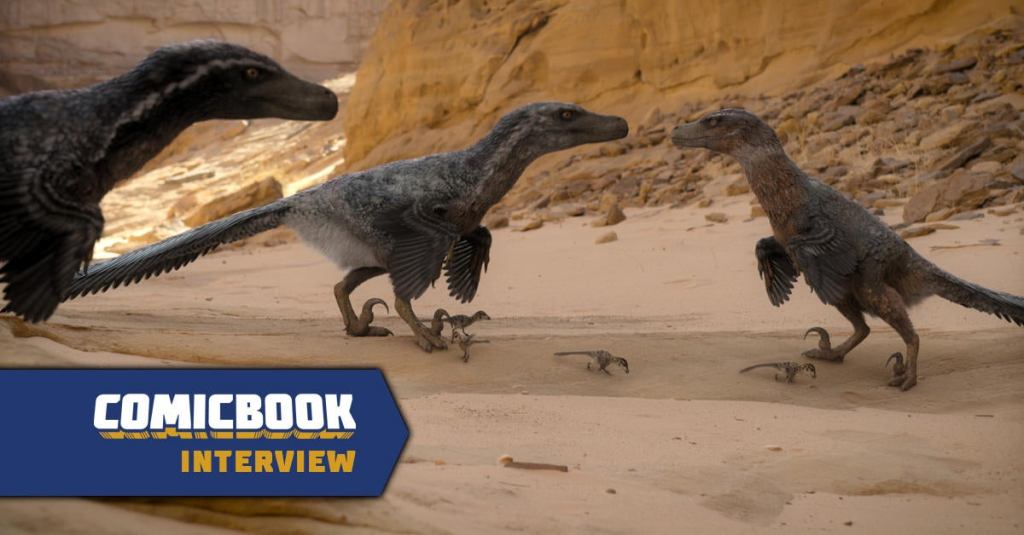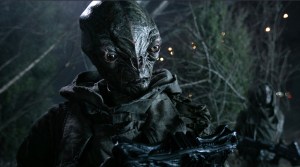The premiere of Prehistoric Planet on Apple TV+ transported audiences millions of years back in Earth’s history, embracing the spirit of beloved natural history documentaries to showcase what life would have really been like when dinosaurs ruled the planet. The success of that debut season allowed for the development of Prehistoric Planet 2, which displays all-new creatures at the height of their reign, depicting just how majestic these creatures were before their eventual demise. The new season came to life courtesy of executive producer Mike Gunton, showrunner Tim Walker, and paleontologist Dr. Darren Naish. Prehistoric Planet 2 premieres on Apple TV+ on May 22nd in a five-night event.
Videos by ComicBook.com
Prehistoric Planet combines award-winning wildlife filmmaking, the latest paleontology learnings, and state-of-the-art technology to unveil the spectacular habitats and inhabitants of ancient Earth for a one-of-a-kind immersive experience. The series is produced by the world-renowned team at BBC Studios Natural History Unit with support from the photorealistic visual effects of MPC (The Lion King, The Jungle Book) applied to concept art created by Jellyfish Pictures (The Book of Boba Fett, Spirit: Untamed). Prehistoric Planet Season 2 continues to bring Earth’s history to life like never before as the series presents new dinosaurs, new habitats, and new scientific discoveries while taking viewers around the world in an epic five-night adventure. With new dinosaurs like the Tarchia, one of the largest ankylosaurs, to returning fan-favorites like the Tyrannosaurus rex, and many more, Prehistoric Planet returns with an all-new season of prehistoric wonders.
ComicBook.com caught up with Gunton, Walker, and Dr. Naish to discuss bringing the series to life, their favorite dinosaurs, and more.

ComicBook.com: First things first, we’re going to go rapid-fire here and everyone’s going to give an answer. This could be the hardest question you have to answer, but I just want to hear what everyone’s favorite dinosaur is.
Tim Walker: I can’t go anywhere without T-Rex. Right? I know it’s a cliche, but I think it is a majestic animal. And over the course of the two seasons of Prehistoric Planet, we depicted T-Rex in a way that people have never seen before. Not just physically, because we’ve got the latest interpretation of how it would look, but also the behaviors that we see. In Season 1, we saw it swimming. We saw it looking after its young. We saw it in a courtship dance. In Season 2, we see it doing an unusual suite of behaviors that people just won’t expect. So we’re bringing the familiar face, but the unexpected behavior, and I just think you can’t have a dinosaur series without it.
Mike Gunton: He gets in there first with T-Rex. It’s annoying. No, I agree.
I’m actually going to pick an animal that isn’t strictly a dinosaur. It’s a Pterosaur. It’s a flying reptile. I think the Hatzegopteryx. Of all the animals, I would love to see that, I would love to see Quetzalcoatlus or Hatzegopteryx. One of those giant Pterosaurs. Both in the air and on the ground. I think I’d be a bit scared of it on the ground, but I think it must be one of the ultimate hunters of all time, yet nobody knows anything about it, or wouldn’t know much about it. It’s a real mystery creature, only relatively recently found out about, but I think we have brought it to life in a way that has completely blown people’s minds. It’s certainly blown my mind, so that would be my favorite.
Dr. Naish, there’s two off the table, so I don’t know how you’re going to come up with your favorite.
Dr. Darren Naish: My favorite dinosaur changes on a regular basis, and the answer I give depends on the context. So out of all of them, well, sticking with the dinosaurs that we’ve got in Season 2 of Prehistoric Planet, I will go with that well-known superstar dinosaur Imperobator. Known from the Late Cretaceous of Antarctica, represented only by a foot. We represent this animal in a really interesting way. It looks fantastic. And to see why I’ve gone for it as a favorite, you’ll have to see what it does in the series. Because it just looks awesome. Imperobator, why not?
Thank you all for your honest and candid answers. My favorite’s Deinonychus, I’ve always had a soft spot for that one. Dr. Naish, through all of your experiences working with the public, what do you feel is the most common misconception about dinosaurs and what is so exciting about how Prehistoric Planet addresses those misconceptions?
Dr. Naish: There are so many misconceptions that are prevalent about dinosaurs. And I would say, top of the list, is that they’re extinct. So, dinosaurs aren’t extinct. If you haven’t all died, if some of you are still alive, you’re not extinct. Dinosaurs, at least four different groups, survived the end-Cretaceous extinction event. I am, of course, talking about birds. Birds are a group of dinosaurs, in the same way that we are primates. And, of course, there’s about 10,000 different species today. So that’s my favorite thing. Dinosaurs aren’t extinct. There are other things, but that’s the top of the list.
What I love about this series, especially the second season, you start off right away with how the study of dinosaurs, and just the show itself, is constantly evolving. What you thought used to be true is no longer true. So when it came to developing Prehistoric Planet 2, were there any instances where you were planning on doing one thing and then while developing the series, new science came out, or new evidence came out, that you then had to modify any of your plans?
Gunton: Well, inevitably that happens at different levels. They’re little tweaks on the rudder. But I think one of the things that’s been very gratifying, actually, is that, because one of the challenges of making a series, is you have to make your decisions very early on. There can be anything from, is a T-Rex going to have lips, for example. Or are Velociraptors going to have feathers? And we had to make decisions a long, long time ago, and stick to that. There’s always an anxiety that, not just there’ll be small changes in micro details, but something will fundamentally change a whole perspective of dinosaurs. What’s been great is that, all the calls — Darren will have to confirm this — but I’m pretty sure all the calls we’ve made have proved to be right, and have subsequently been verified by papers that have been written.
That’s many thanks to Darren and his huge network of collaborators. But that’s very gratifying, because it speaks to, I think, one of the things that perhaps people don’t even realize as much that I’m incredibly proud of, which is the level of scholarship. Of course, this is entertainment, these are documentaries, these are empathetic, they’re exciting, but they’re absolutely enormously driven by scholarship. I think that’s something that, when people look back on this in 15-20 years’ time, I think it will establish, this is a snapshot of what we know about this world in 2022-2023. That’s a big responsibility to get right, because it does establish a baseline. So we felt it was important to get it right, but I think we have.
Speaking to that evolution of the science that we know about dinosaurs, when it comes to the evolution of visual effects techniques, when it comes to bringing these animals to life, from Season 1 to Season 2, were there any dramatic shifts or techniques available that you were really able to take the series to a new height? Also, along those lines, was there a particularly challenging sequence that was really tough to nail?
Walker: We’ve incorporated lots more new camera techniques into Season 2 from Season 1, just as we would do if we were doing a follow-up to Planet Earth. So Planet Earth into Planet Earth 2, you see more advanced camera techniques. Planet Earth 2 into Planet Earth 3, you would see more, and we followed the same rationale.
So in Season 2, we now see thermal imaging to show the body heat of dinosaurs. We see a lot of slow motion to really highlight the detail in some of the air action sequences. And by action, I don’t mean literally running and fighting, I just mean the action. We see a lot of long lens use, as we would do with advances in lens technology, and so we really see the detail in the animals. Then we see developments in the science, which have informed some of the CGI, as well.
We worked very closely with the paleo world, as already has been said, and, in some cases, it’s driven the story which then drives the CGI. In one particular example, we wanted to show a story about Mosasaurus and its hunting capabilities. We had a good idea that it would be able to rapidly increase its speed in the water, but we wanted to find out exactly how it could do it, and so we worked with some colleagues over in the States who did a series of studies to determine the velocity that the Mosasaurus could achieve to enable it to hunt. That then drove the CGI because we could develop the story in a certain way, and the artists could then utilize developments from the science side of things into the creation of the movement of the animal, which has then culminated in, I don’t know whether you’ve seen the wonderful artwork of the Mosasaurus jumping out of the water with the Elasmosaurus in his mouth. So the science has always driven the series, but the series drives the science as well. Which then drives the CGI.
How do you navigate the idea of wanting to offer the most accurate information possible for Prehistoric Planet, while also knowing that the most accurate information might not make for the most exciting television? Do you have to find that balance of fact versus fiction or do you think, since the goal of Prehistoric Planet is to be authentic, that you don’t have to deal with that challenge?
Dr. Naish: It’s an interesting question, and I think that would best be answered, actually, by Mike in view of his career in the business. But this is a field where, while, as Mike has already said, we set out to entertain, people aren’t going to watch this if they’re not entertained. But you are representing the natural world the best as we understand it. You are presenting a scientific view of the world, so we aren’t working in the same ecosystem as people making action movies. We are not looking at a dinosaur saying, “How can we turn it into a monster that’s going to be a danger to human protagonists?” for example. We are like, “This is what we think Velociraptor or Tyrannosaurus looks like. This is what the evidence says. This is what we’re going to go for, and if you want something else, tough. We’re going with what the evidence says.”
That’s our remit across the board. We all agree on this: what is more interesting and more exciting than nature? Things are true whether you like it or not. And I think we prove, and it’s present throughout this whole genre of filmmaking, that if you represent things as they are, people do love it. They do understand it. They learn something from it. They take something really valuable away from it. So no, there was never a need or I was never goaded, prodded with a stick to say, give T-Rex more teeth. That was never, ever part of our remit.
Are there plans for a third series to maybe cover the few other dinosaurs that you haven’t covered yet or do you think this is more of a two-part thing that is complete and you’ll explore some other projects?
Gunton: I think you better ask our friends at Apple about that. But, of course, there are 400 million years at least of fascinating pre-history that is crying out to be brought to an audience because it’s fantastic.
Just referring to that question that Darren answered a moment ago, I’ve done this for many, many years and almost every time I start a new series, people say, “But haven’t you done it all before? Haven’t you done it all? Is there anything new?” And the answer to that is, there absolutely is. Because nothing is stranger than Mother Nature. But also truth is stranger than fiction.
We’ve been quite conservative in some of our representations of the behavior and the animals themselves. And scientists, and many of Darren’s colleagues, have said, “I’m surprised you’ve been quite conservative. But good, I’m glad you have.” Because I’d rather step on that side. If you turn the camera away from what we’re filming to the real animals, the bizarreness of Mother Nature is so mind-blowing that if we recreated that in CG, nobody would ever believe you. So it’s probably right to be on the conservative side.
Long answer is: yes, of course we’d love to do more. And also Darren, none of us had any problem, because all these stories are so cool. There was nothing boring. Everything, was like, “Really? They do that?” And it was just our joy and our pleasure to be able to say, “Right, let’s bring that to life in this process.”
Prehistoric Planet 2 premieres on Apple TV+ on May 22nd. The companion podcast, Prehistoric Planet: The Official Podcast, is a four-part audio series that dives further into the making of the series.
This interview has been edited for length and clarity. You can contact Patrick Cavanaugh directly on Twitter.








